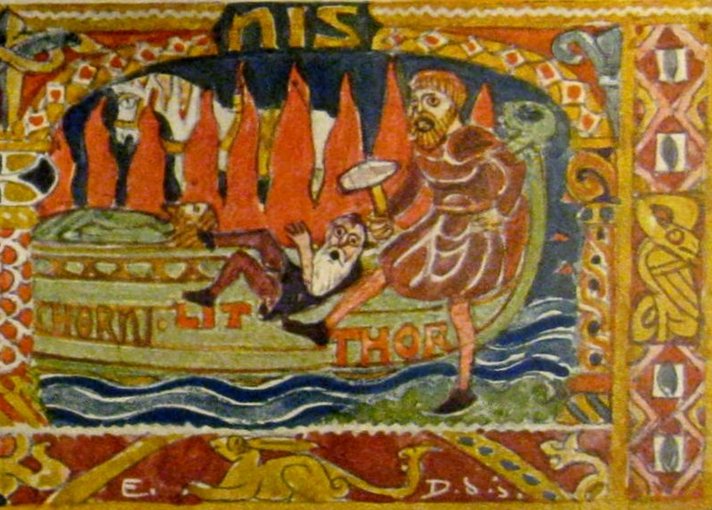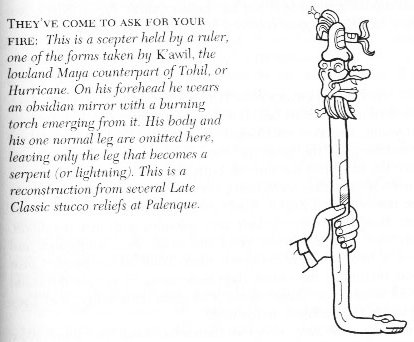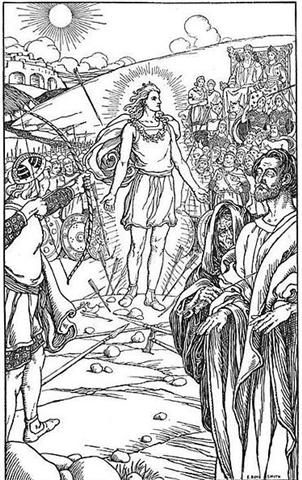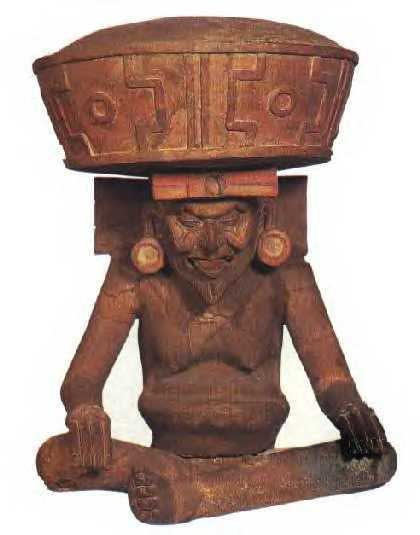At midsummer there was a fire followed by a sea voyage. ... The bereaved and sorrowing Isis, meanwhile, wandering over the world in her quest - like Demeter in search of the lost Persephone - came to Byblos, where she learned of the wonderful tree. And, placing herself by a well of the city, in mourning, veiled and in humble guise - again like Demeter - she spoke to none until there approached the well the handmaidens of the queen, whom she greeted kindly. Braiding their hair, she breathed upon them such a wondrous perfume that when they returned and Astarte saw and smelt the braids she sent for the stranger, took her into the house, and made her the nurse of her child. The great goddess gave the infant her finger instead of breast to suck and at night, having placed him in a fire to burn away all that was mortal, flew in the form of a swallow around the pillar, mournfully chirping. But the child's mother, Queen Astarte, happening in upon this scene, shrieked when she spied her little son resting in the flames and thereby deprived him of the priceless boon. Whereupon Isis, revealing her true nature, begged for the pillar and, removing the sarcophagus, fell upon it with a cry of grief so loud that the queen's child died on the spot. Sorrowing, then, the two women placed Osiris's coffer on a boat, and when the goddess Isis was alone with it at sea, she opened the chest and, laying her face on the face of her brother, kissed him and wept ... ... At midsummer, at the end of a half-year reign, Hercules is made drunk with mead and led into the middle of a circle of twelve stones arranged around an oak, in front of which stands an altar-stone; the oak has been lopped until it is T-shaped. He is bound to it with willow thongs in the 'five-fold bond' which joins wrists, neck, and ankles together, beaten by his comrades till he faints, then flayed, blinded, castrated, impaled with a mistletoe stake, and finally hacked into joints on the altar-stone. His blood is caught in a basin and used for sprinkling the whole tribe to make them vigorous and fruitful. The joints are roasted at twin fires of oak-loppings, kindled with sacred fire preserved from a lightning-blasted oak or made by twirling an alder- or cornel-wood fire-drill in an oak log. The trunk is then uprooted and split into faggots which are added to the flames. The twelve merry-men rush in a wild figure-of-eight dance around the fires, singing ecstatically and tearing at the flesh with their teeth. The bloody remains are burnt in the fire, all except the genitals and the head. These are put into an alder-wood boat and floated down the river to an islet; though the head is sometimes cured with smoke and preserved for oracular use. His tanist succeeds him and reigns for the remainder of the year, when he is sacrificially killed by a new Hercules ... Alternatively the fire was generated at the point where the ship was launched:
... According to Gylfaginning, following the murder of Baldr by Loki, the other gods brought his body down to the sea and laid him to rest on the ship. They would have launched it out into the water and kindled a funeral pyre for Baldr but were unable to move the great vessel without the help of the giantess Hyrrokkin, who was sent for out of Jötunheim. She then flung the ship so violently down the rollers at the first push that flames appeared and the earth trembled, much to the annoyance of Thor. Along with Baldr, his wife Nanna was also borne to the funeral pyre after she had died of grief. As Thor was consecrating the fire with his hammer Mjolnir, a dwarf named Litr began cavorting at his feet. Thor then kicked him into the flames and the dwarf was burned up as well ... The name of the mighty force behind the fire was Hyrrokin which is remarkably similar to Hun-rakan (One Leg, Hurricane):
... They walked in crowds when they arrived at Tulan, and there was no fire. Only those with Tohil had it: this was the tribe whose god was first to generate fire. How it was generated is not clear. Their fire was already burning when Jaguar Quitze and Jaguar Night first saw it: 'Alas! Fire has not yet become ours. We'll die from the cold', they said. And then Tohil spoke: 'Do not grieve. You will have your own even when the fire you're talking about has been lost', Tohil told them. 'Aren't you a true god! Our sustenance and our support! Our god!' they said when they gave thanks for what Tohil had said. 'Very well, in truth, I am your god: so be it. I am your lord: so be it,' the penitents and sacrificers were told by Tohil. And this was the warming of the tribes. They were pleased by their fire. After that a great downpour began, which cut short the fire of the tribes. And hail fell thickly on all the tribes, and their fires were put out by the hail. Their fires didn't start up again. So then Jaguar Quitze and Jaguar Night asked for their fire again: 'Tohil, we'll be finished off by the cold', they told Tohil. 'Well, do not grive', said Tohil. Then he started a fire. He pivoted inside his sandal ... And the name Tohil, in turn, can hardly be anything else than the name for the ceremony which Makea performed in error, thus making it impossible for his son to go up in flames and that way become immortal: ... 'My child', said Makea now in a tone of deep sorrow, 'there has been a bad omen for us. When I performed the tohi ceremony over you I missed out a part of the prayers. I remembered it too late. I am afraid this means that you are going to die.' 'What's she like, Hine nui te Po?' asked Maui. 'Look over there', said Makea, pointing to the ice-cold mountains beneath the flaming clouds of sunset. 'What you see there is Hine nui, flashing where the sky meets the earth. Her body is like a woman's, but the pupils of her eyes are greenstone and her hair is kelp. Her mouth is that of a barracuda, and in the place where men enter her she has sharp teeth of obsidian and greenstone ... The Polynesian language does not allow words to end in a consonant, therefore Tohil had to be Tohi. The name of the dwarf which Thor kicked into the flames was Litr, which had me puzzled. But now I have found out that it probably originated from the Greek word for weight (litra). One liter (litr), the Swedish measure for 1/1000 of one cubic meter of water, weighs - has been defined as - 1 kg. The Greek root became Libra in Latin - where there is one weight on each side.
... In the inscriptions of Dendera, published by Dümichen, the goddess Hathor is called 'lady of every joy'. For once, Dümichen adds: Literally ... 'the lady of every heart circuit'. This is not to say that the Egyptians had discovered the circulation of the blood. But the determinative sign for 'heart' often figures as the plumb bob at the end of a plumb line coming from a well-known astronomical or surveying device, the merkhet. Evidently, 'heart' is something very specific, as it were the 'center of gravity' ... See Aeg.Wb. 2, pp. 55f. for sign of the heart (ib) as expressing generally 'the middle, the center' ... At Spica was Alcor high above and the string between them implied Spica ought to be a weight ('heart'). ... Proclus informs us that the fox star nibbles continuously at the thong of the yoke which holds together heaven and earth; German folklore adds that when the fox succeeds, the world will come to its end. This fox star is no other than Alcor, the small star g near zeta Ursae Majoris (in India Arundati, the common wife of the Seven Rishis, alpha-eta Ursae ... At Wezen (Weight) the star Al Baldah was close to the Full Moon and at midsummer (I think) was the funeral pyre for Baldr, names which by coincidence could be similar. But I doubt it.
The 'center of gravity' surely was at Wasat (Middle), which at the time of Bharani was in day 148 ("May 28). At the time of the Bull the date for the heliacal rising of Aldebaran had been MARCH 21, but at the time of rongorongo the precession had moved Aldebaran to day 68 after 0h, i.e. to May 28.
... This particular 'sky-entering' is not the one mentioned in the Palenque text. It is the final event that occurred in the previous creation before the universe was remade. Before the sky could be raised and the real sun revealed in all its splendor, the Hero Twins had to put the false sun, Itzam-Yeh, in his place. If the date on this pot corresponds to that pre-Columbian event, as we believe it does, then Itzam-Yeh was defeated on 12.18.4.5.0 1 Ahaw 3 K'ank'in (May 28, 3149 B.C.). After the new universe was finally brought into existence, First Father also entered the sky by landing in the tree, just as Itzam-Yeh did ...
... In the morning of the world, there was nothing but water. The Loon was calling, and the old man who at that time bore the Raven's name, Nangkilstlas, asked her why. 'The gods are homeless', the Loon replied. 'I'll see to it', said the old man, without moving from the fire in his house on the floor of the sea. Then as the old man continued to lie by his fire, the Raven flew over the sea. The clouds broke. He flew upward, drove his beak into the sky and scrambled over the rim to the upper world. There he discovered a town, and in one of the houses a woman had just given birth ...
The fish rising at Wezen was followed 4 days later by a descending fish:
At the very bottom was the man at the fire (Nangkilstlas). The loon was calling because the gods had no home. I will fix it promised the man at the fire. And surely, at the close of the myth, Raven learns how to create a new land: ... Hala qaattsi ttakkin-gha, a voice said: 'Come inside, my grandson.' Behind the fire, at the rear of the house, was an old man white as a gull. 'I have something to lend you', said the old man. 'I have something to tell you as well. Dii hau dang iiji: I am you.' Slender bluegreen things with wings were moving between the screens at the back of the house. Waa'asing dang iiji, said the old man again: 'That also is you.' The old man gave the Raven two small sticks, like gambling sticks, one black, one multicoloured. He gave him instructions to bite them apart in a certain way and told him to spit the pieces at one another on the surface of the sea. The Raven climbed back up the pole, where he promptly did things backwards, just to see if something interesting would occur, and the pieces bounced apart. It may well be some bits were lost. But when he gathered what he could and tried again - and this time followed the instructions he had been given - the pieces stuck and rumpled and grew to become the mainland and Haida Gwaii ... By the force of fire the air will carry humidity upwards. At the high mountains where it is cold, the air will loose this ability and the sweet water will fall down as rain. The risinng fish illustrates the first phase and the descending fish the other. ... The life-force of the earth is water. God moulded the earth with water. Blood too he made out of water. Even in a stone there is this force, for there is moisture in everything. But if Nummo is water, it also produces copper. When the sky is overcast, the sun's rays may be seen materializing on the misty horizon. These rays, excreted by the spirits, are of copper and are light. They are water too, because they uphold the earth's moisture as it rises. The Pair excrete light, because they are also light ... 'The sun's rays,' he went on, 'are fire and the Nummo's excrement. It is the rays which give the sun its strength. It is the Nummo who gives life to this star, for the sun is in some sort a star.' It was difficult to get him to explain what he meant by this obscure statement. The Nazarene made more than one fruitless effort to understand this part of the cosmogony; he could not discover any chink or crack through which to apprehend its meaning. He was moreover confronted with identifications which no European, that is, no average rational European, could admit. He felt himself humiliated, though not disagreeably so, at finding that his informant regarded fire and water as complementary, and not as opposites. The rays of light and heat draw the water up, and also cause it to descend again in the form of rain. That is all to the good. The movement created by this coming and going is a good thing. By means of the rays the Nummo draws out, and gives back the life-force. This movement indeed makes life ...
|
|||||||||||||||||||||||||||||||||||||||||||||||||||||||||||||||||||||||||||||||||||||||||||||||||||||||||||||||||||||||||||||||||||||||||||||||||||||||||||||||||||||||||||||










